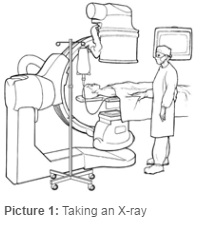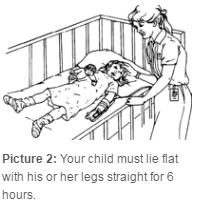Angiogram
![]()
An angiogram (AN jee oh gram), also called an arteriogram (ar TEER ee oh gram) is a test that is done to study the size and shape of your child's blood vessels.
This test is done in the IR (Interventional Radiology Department). Your child will be admitted to the hospital after the procedure.
A special dye is injected into a tube that is inserted into an artery (usually in the groin area) so the blood vessels can be seen on X-rays.
Important: X-ray dyes and special medicines used to relax your child are given during the test.
Be sure to tell the doctor if your child has any allergies.
Preparing for the Test
Explain to your child what will happen during the test in a way he or she can understand. Your child will have medicine (sedation) to help him relax or general anesthesia for this test.
It is very important to follow the following instructions exactly.
Preparing for the Test: Food and Drink
- Your child may have CLEAR LIQUIDS up to 2 hours before surgery. After that, he may have nothing else to drink. Clear liquids are those you can see through that have no pulp or food bits in them. Examples of clear liquids are water, apple juice, white grape juice and Pedialyte®.
- Your child may have breast milk up to 4 hours and formula up to 6 hours before surgery and water or Pedialyte® up to 2 hours before surgery. All other liquids, semi-liquids and solid foods MUST BE STOPPED 8 hours before surgery.
- Gum, cough drops and hard candy are not allowed. If your child has been chewing gum, surgery will be delayed 2 hours from the time the gum is spit out. If the gum has been swallowed, surgery will be delayed 6 hours from the time it was swallowed.
- If your child is having general anesthesia, please follow the directions that the Surgery Unit will give you the night before the test.
If you have any questions about this, please call the doctor who ordered the test or the Interventional Radiology Department where the test is being done.
Preparing for the Appointment
- A PARENT OR LEGAL GUARDIAN MUST BE WITH YOUR CHILD to give information on the child’s health and sign forms for consent for the test and for sedation or general anesthesia. If a parent or legal guardian is not available, please have a phone number where a doctor or nurse can reach him or her at the time of the test.
- Child Care: please try to arrange for childcare for other children in the family for the day of the test.
- If your child is ill with a fever, stuffy nose or cough we may need to re-schedule. Please call the IR (Interventional Radiology) Department at (614) 722-2420.
- General Anesthesia – If your child is having general anesthesia to make him sleep through the test, you will get a call from the Surgery Unit the evening before the test. They will tell you where and when to bring your child and will give you further instructions about eating and drinking.
Before the Test
A nurse or anesthesiologist will complete a medical history and physical exam on your child and will explain the sedation medicine that will be used.
- Any female who is menstruating or is 12 years of age or older will get a urine pregnancy test at the hospital the day of the test.
- Your child will wear a hospital gown.
- You may go with your child to the IR procedure room.
How the Test is Done
Your child will be taken on a cart or in the hospital bed to a room in the Radiology Department and moved to a padded table. A large machine overhead takes the X-ray pictures (Picture 1).
- The table and the X-ray machine can be moved back and forth to get the best picture.

- The radiologist will explain the test to you and get your consent. You will also need to give consent for sedation or general anesthesia.
- After consent is obtained, you will be asked to leave before the test starts, as it is done in a sterile environment. You may wait in the IR waiting room, the Surgery waiting room, if your child is having general anesthesia, or you may go to your child’s hospital room.
- Your child will be connected to a heart monitor and pulse oximeter so the nurse can monitor him or her during the procedure. The nurse, radiologist (x-ray doctor) or anesthesiologist will stay with your child the whole time.
- If your child is to be sedated:
- The child will have an IV started before the test.
- The nurse will explain the sedation that will be used. The sedation will be given through your child’s IV.
- If your child is having general anesthesia:
- The nurse anesthetist or anesthesiologist will explain the anesthesia that will be used.
- Your child will have an IV for this procedure.
- It is very important your child stays perfectly still during the test. To help your child stay still while sedated and while X-rays are being taken, he may be held in place with safety straps across his forehead and legs.
- The doctor will feel for your child's pulse in the groin area, clean this area with liquid soap, and put gauze on the area to keep it clean. Sometimes a creamy medicine called EMLA® is put on the skin one hour before the injection to numb the area. Next the doctor will inject some medicine under the skin to make the area numb. This will burn for a few seconds and then feel numb.
- After the area is numb, the doctor will put a needle into the child's artery. A small tube (catheter) will be put into the artery and the needle will be removed. The X-ray dye will be injected into the catheter. This dye might make your child feel warm all over but the feeling only lasts a short time.
- Pictures will be taken with the X-ray machine and fluoroscope. After the pictures are taken, the catheter will be taken out. Pressure will be applied over the catheter area for 15 minutes to prevent any bleeding. Then a bandage will be put on.
If your child had general anesthesia, he or she will go to the PACU (Post Anesthesia Care Unit). Once your child is awake he will be taken to his room where he can be watched closely by the nurse.
If your child was given medicine to make him or her sleepy, he will be taken back to his room where he will be watched closely by the nurse.
A parent or other caregiver will need to stay with your child the rest of the day.
After the Test
When your child is back in his room, his nurse will check the bandage often to make sure there is no bleeding. Vital signs (blood pressure, pulse and respirations) will also be checked often.
- Your child must lie flat in bed with his leg straight for 6 hours (Picture 2). He will not be allowed to go to the bathroom and will need to use a bedpan or urinal.

- When your child is awake, he may have some liquids to drink. When he is fully awake, he may have his regular food.
- Your child's doctor will tell you the results of the test in the evening.
- The effects of the sedation may last for 24 hours, so your child should be watched closely. When your child is allowed out of bed, he will not be allowed to walk on his own. It is normal for children to be sleepy or irritable after sedation.
When to Call the Doctor
After you are home, call your child's doctor if your child has:
- Any bleeding or swelling at the injection site in the groin area.
- If the leg on the side of the injection feels numb or is cooler than the other leg.
If you have any questions or need to cancel or reschedule, call the Interventional Radiology Department at (614) 722-2420.
HH-III-25 4/85, Revised 3/16 Copyright 1985, Nationwide Children’s Hospital



